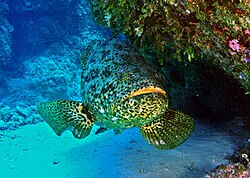| Atlantic goliath grouper | |
|---|---|
 | |
| Scientific classification | |
| Kingdom: | Animalia |
| Phylum: | Chordata |
| Class: | Actinopterygii |
| Order: | Perciformes |
| Family: | Epinephelidae |
| Genus: | Epinephelus |
| Species: | E. itajara |
| Binomial name | |
| Epinephelus itajara (Lichtenstein, 1822) | |
| Synonyms [2] | |
| |
The Atlantic goliath grouper or itajara (Epinephelus itajara), historically known as the jewfish, [3] [4] is a saltwater fish of the grouper family and one of the largest species of bony fish. The species can be found in the West Atlantic ranging from northeastern Florida, south throughout the Gulf of Mexico and the Caribbean Sea, and along South America to Brazil. In the East Pacific it ranges from Mexico to Peru. [5] In the East Atlantic, the species ranges in West Africa from Senegal to Cabinda. The species has been observed at depths ranging from 1 to 100 meters (3 to 300 ft). [1]


